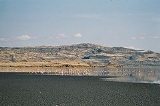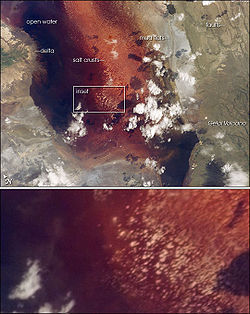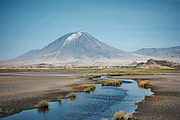
Lake Natron
Encyclopedia

Salt lake
A salt lake or saline lake is a landlocked body of water which has a concentration of salts and other dissolved minerals significantly higher than most lakes . In some cases, salt lakes have a higher concentration of salt than sea water, but such lakes would also be termed hypersaline lakes...
located in northern Tanzania
Tanzania
The United Republic of Tanzania is a country in East Africa bordered by Kenya and Uganda to the north, Rwanda, Burundi, and the Democratic Republic of the Congo to the west, and Zambia, Malawi, and Mozambique to the south. The country's eastern borders lie on the Indian Ocean.Tanzania is a state...
, close to the Kenya
Kenya
Kenya , officially known as the Republic of Kenya, is a country in East Africa that lies on the equator, with the Indian Ocean to its south-east...
n border, in the eastern branch of Africa
Africa
Africa is the world's second largest and second most populous continent, after Asia. At about 30.2 million km² including adjacent islands, it covers 6% of the Earth's total surface area and 20.4% of the total land area...
's Great Rift Valley
Great Rift Valley
The Great Rift Valley is a name given in the late 19th century by British explorer John Walter Gregory to the continuous geographic trench, approximately in length, that runs from northern Syria in Southwest Asia to central Mozambique in South East Africa...
. The lake is fed by the Ewaso Ng'iro
Ewaso Ng'iro
Ewaso Ng'iro is a river in Kenya which rises on the west side of Mount Kenya and flows north then east and finally south-east, passing through Somalia where it joins the Jubba River....
River but also by mineral-rich hot springs and is quite shallow, less than three meters (10 feet) deep, and varies in width depending on its water level, which changes due to high levels of evaporation, leaving high levels of salt and other minerals. The surrounding country is dry and receives irregular rainfall. Temperatures in the lake can reach 50 degrees Celsius (120 degrees Fahrenheit), and depending on rainfall, the alkalinity can reach a pH
PH
In chemistry, pH is a measure of the acidity or basicity of an aqueous solution. Pure water is said to be neutral, with a pH close to 7.0 at . Solutions with a pH less than 7 are said to be acidic and solutions with a pH greater than 7 are basic or alkaline...
of 9 to 10.5 (almost as alkaline as ammonia
Ammonia
Ammonia is a compound of nitrogen and hydrogen with the formula . It is a colourless gas with a characteristic pungent odour. Ammonia contributes significantly to the nutritional needs of terrestrial organisms by serving as a precursor to food and fertilizers. Ammonia, either directly or...
).
Flora
The color of the lake is characteristic of those where very high evaporationEvaporation
Evaporation is a type of vaporization of a liquid that occurs only on the surface of a liquid. The other type of vaporization is boiling, which, instead, occurs on the entire mass of the liquid....
rates occur. As water evaporates during the dry season, salinity levels increase to the point that salt-loving microorganism
Microorganism
A microorganism or microbe is a microscopic organism that comprises either a single cell , cell clusters, or no cell at all...
s begin to thrive. Salt-loving organisms include some cyanobacteria, tiny bacteria that grow in water and make their own food with photosynthesis
Photosynthesis
Photosynthesis is a chemical process that converts carbon dioxide into organic compounds, especially sugars, using the energy from sunlight. Photosynthesis occurs in plants, algae, and many species of bacteria, but not in archaea. Photosynthetic organisms are called photoautotrophs, since they can...
as plants do. The red pigment in the cyanobacteria produces the deep reds of the open water of the lake, and orange colors of the shallow parts of the lake. The alkali
Alkali
In chemistry, an alkali is a basic, ionic salt of an alkali metal or alkaline earth metal element. Some authors also define an alkali as a base that dissolves in water. A solution of a soluble base has a pH greater than 7. The adjective alkaline is commonly used in English as a synonym for base,...
salt crust on the surface of the lake is also often colored red or pink by the salt-loving microorganism
Microorganism
A microorganism or microbe is a microscopic organism that comprises either a single cell , cell clusters, or no cell at all...
s that live there.
Salt marsh
Salt marsh
A salt marsh is an environment in the upper coastal intertidal zone between land and salt water or brackish water, it is dominated by dense stands of halophytic plants such as herbs, grasses, or low shrubs. These plants are terrestrial in origin and are essential to the stability of the salt marsh...
es and freshwater wetlands around the edges of the lake do support a variety of plants.
Fauna
The high temperature (up to 41°C) and the high and very variable salt content of the lake does not support most wildlife. However it is an important habitat for flamingos and is home to endemic algae, invertebrates and even fish that can survive in the salty water.The lake is the only regular breeding area in East Africa for the 2.5 million endangered Lesser Flamingo
Lesser Flamingo
The Lesser Flamingo is a species in the flamingo family of birds that resides in Africa and in southern Asia...
es. As salinity increases, so do the number of cyanobacteria, and the lake can support more nests. These flamingoes, the largest flock in East Africa, gather along saline lakes in the region, where they feed on Spirulina (a blue-green algae
Algae
Algae are a large and diverse group of simple, typically autotrophic organisms, ranging from unicellular to multicellular forms, such as the giant kelps that grow to 65 meters in length. They are photosynthetic like plants, and "simple" because their tissues are not organized into the many...
with red pigments). Lake Natron is a safe breeding location for Lesser Flamingoes, because its caustic environment is a barrier against predators trying to reach their nests. Greater Flamingo
Greater Flamingo
The Greater Flamingo is the most widespread species of the flamingo family. It is found in parts of Africa, southern Asia , and southern Europe...
also breed on the mud flats.
Even more amazing than the ability of the flamingoes to live in these conditions is the fact that two endemic fish species, the alkaline tilapias
Alcolapia
Alcolapia is a genus of fishes in the Cichlidae family. Their native range is largely restricted to the hypersaline, warm Lake Natron and Lake Magadi in Kenya and Tanzania, although two species also have been introduced to Lake Nakuru.-Species:...
(Alcolapia latilabris
Alcolapia latilabris
Alcolapia latilabris is a species of small fish in the Cichlidae family. It is endemic to the hypersaline, warm Lake Natron in Tanzania....
and A. ndalalani
Alcolapia ndalalani
Alcolapia ndalalani is a species of small fish in the Cichlidae family. It is endemic to the hypersaline, warm Lake Natron in Tanzania....
; A. alcalica
Alcolapia alcalica
Alcolapia alcalica is an endangered species of fish in the Cichlidae family. It is endemic to the hypersaline, warm Lake Natron, its drainage and the Shombole swamps in Kenya and Tanzania, but has also been introduced to Lake Nakuru.-References:...
is also present in the lake, but not endemic), thrive in the waters at the edges of the hot spring inlets.
Threats and preservation
The area around the salt lake is not inhabited but there is some herding and some seasonal cultivation. Threats to the salinity balance from increased fresh water influxes will come from more projected loggingLogging
Logging is the cutting, skidding, on-site processing, and loading of trees or logs onto trucks.In forestry, the term logging is sometimes used in a narrow sense concerning the logistics of moving wood from the stump to somewhere outside the forest, usually a sawmill or a lumber yard...
in Natron watersheds and a planned hydroelectric power plant on the Ewaso Ng'iro across the border in Kenya
Kenya
Kenya , officially known as the Republic of Kenya, is a country in East Africa that lies on the equator, with the Indian Ocean to its south-east...
. Although development plans include construction of a dike at the north end of the lake to contain the fresh water, the threat of dilution to this breeding ground may still be serious. There is no formal protection.
A new threat to Lake Natron is the proposed development of a soda ash plant on its shores. The plant would pump water from the lake and extract the sodium carbonate to convert to washing powder for export. Accompanying the plant would be housing for over 1000 workers, and a coal fired power station to provide energy for the plant complex. In addition, there is a possibility the developers may introduce a hybrid brine shrimp to increase the efficiency of extraction.

As per communication as on June 2008 Tata Chemicals shall not proceed with the Natron Project and further re-examination of this project will be subject to the Ramsar Wetlands plan which is currently under preparation.
Because of its unique biodiversity, Tanzania named the Lake Natron Basin to the Ramsar List of Wetlands of International Importance
Ramsar list of wetlands of international importance
This is the list of wetlands of international importance as defined by the Ramsar Convention for the conservation and sustainable utilization of wetlands, recognizing the fundamental ecological functions of wetlands and their economic, cultural, scientific, and recreational value.The Convention...
on July 4, 2001. The lake is also the World Wildlife Fund East African halophytics ecoregion
Ecoregion
An ecoregion , sometimes called a bioregion, is an ecologically and geographically defined area that is smaller than an ecozone and larger than an ecosystem. Ecoregions cover relatively large areas of land or water, and contain characteristic, geographically distinct assemblages of natural...
.
Visiting the area
There are a number of campgrounds near the lake, which is also the base for climbing Ol Doinyo LengaiOl Doinyo Lengai
Ol Doinyo Lengai is an active volcano located in the north of Tanzania and is part of the volcanic system of the Great Rift Valley in Eastern Africa. It is located in the eastern Rift Valley, south of both Lake Natron and Kenya. It is unique among active volcanoes in that it produces...

